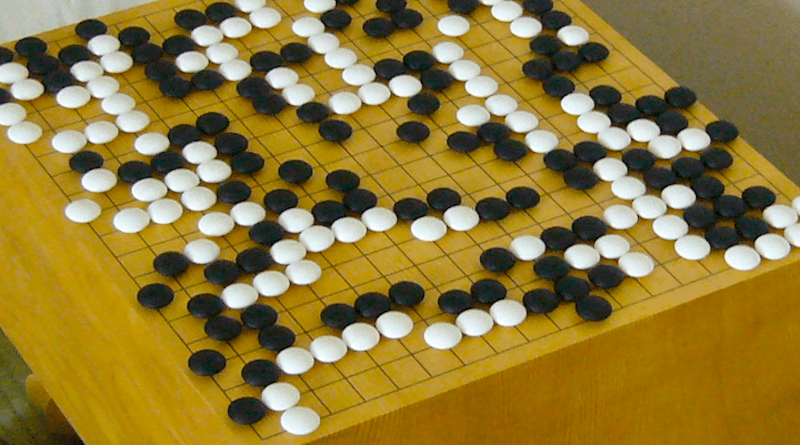China’s Belt and Road Initiative: ‘Go,’ A Game Beyond Chess – OpEd
By Patial RC
President Xi Jinping plays his chess on the world chessboard canvas through his clever moves of the Belt and Road Initiative (BRI) from his strong fort of the Great Hall of the People. President Xi has been aggressively consolidating power around himself since taking office in late 2012. He wears several power hats including heading the party, the PLA and has the final say on everything. Nicknamed the ‘Chairman of Everything’ has all powers relating to decisions on economic and other important issues bestowed upon him. As expected, the Sixth Plenum of the Chinese Communist Party meeting held in Beijing from November 7 to 11 exalted the status of its General Secretary Xi Jinping by including him in a historic resolution which features two former titans, Chairman Mao Zedong and senior leader Deng Xiaoping.
Xi more than chess plays the Chinese game of ‘Go’ which represents a skill and understanding of forward-thinking strategy. Chess which originated in India is a game of manoeuvres and the objective is to capture or “kill” the opponent’s king other losses being immaterial. The Chinese ‘Go’ is played on a much larger board compared to the Chess board. Go has white and black pieces called stones. The objective of ‘Go’ is to surround a larger area on the board with one’s stones before the opponent. The winner is decided by each player’s total captured territory with their respective stones.
Xi’s China expansionist strategy is now to play this ‘Go’ game with the real territory on the global land canvas with no virtual opponents. This ‘Go’ game of expanding or occupying territories started within neighbouring lands like Tibet in 1950. Chinese occupied territories of Mongolia, East Turkestan, Xinjiang (Uyghurs are now completely oppressed).
Now the BRI, the Silk Road of trade, The Pearl Necklace around India and the South China Sea are all part of China’s game of ‘Go’, being played on a much larger scale. Hong Kong, Taiwan, and smaller Indo-pacific countries are at the receiving end of their conquests. China’s aggressive modus operandi continues against the Spratly Islands an ongoing territorial dispute between China, the Philippines, Taiwan, Malaysia, Vietnam, and Brunei, concerning “ownership” of the Spratly Islands. China has been falsely claiming Spratly island territories, and also enlarging new small islands in waters not belonging to them. China’s game of “Go’ BRI has no rules and is leapfrogging across continents occupying ports, lands and trapping nations through debt traps through building infrastructure. China’s Silk roads are less silken but have more poisonous fangs which poison the nation with slow sweet poisoning.
South Asia has been high on the economic expansion agenda of China for the past two decades. China started with the lure of funds, investment and infrastructure for the underdeveloped countries with suffering economies of Myanmar, Pakistan, Sri Lanka and Maldives. The Maldives and Sri Lanka have fallen prey to these Chinese ‘Go’ BRI tricks and are now unable to get out of the debt burdens.
Pakistan is yet to realize the seriousness of the debt trap it is sinking into through their sweet friend; “Pak-China friendship is higher than Himalayas, deeper than ocean, sweeter than honey, and stronger than steel”. As part of the BRI, China through the CPEC (China Pakistan Economic Corridor) has spread all over Pakistan. China is building the Gwadar port. With the US withdrawal from Afghanistan and the Pak-Taliban nexus the Chinese game of ‘Go’ can be expected to reach parts of Afghanistan early.
Many countries in Africa have also fallen under China’s debt trap of ‘Go’ game policy as they have signed away land and resource rights in exchange for long term leases similar to Sri Lanka’s Hambantota port.
High interest loans and exorbitant infrastructure developmental costs levied by Chinese contractors have forced countries to get into debt traps. Beijing has been able to manipulate politicians and policy making in those countries. Even the media has been bought to influence public opinions.
China with its ambitions is unperturbed by global opinions and China continues land grabs or lay claims for more strategic locations along the Bhutan and Indian borders to threaten India’s Siliguri Corridor to enlarge its ‘Go’ game across the Himalayas.
Since Xi’s ascent to power, China has taken an aggressive and expansionary approach, reasserting its claim on the disputed territories as “sovereignty issues” where “it would not concede an inch” and China is likely to remain the biggest challenge for India and the world at large. China’s New Border Law “stipulates that the sovereignty and territorial integrity of the People’s Republic of China are sacred and inviolable”. China is now the world’s leading economic power and it is the leading trading partner of nearly every country including India. China has been manoeuvring its pieces into position on the global canvas using trade, infrastructure and the BRI to dominate what the Western world so far considered their domain . Countries need to selectively stay away from China’s trade dependencies by diversifying their economic trade.
China’s strategy of the silk noose around India from every direction has to be tackled with a counter-strategy. Quad(s) is one recent development along with synergizing other earlier associations. India must make friendly moves towards countries which are increasingly threatened by China like Japan, Australia, Taiwan, Malaysia, South Korea, Singapore, Vietnam, Nepal, Bhutan and Sri Lanka. The like minded community of Nations have to finally come together to counter the Chinese further ‘Go’ ‘Go’ into territories of economically weak nations. India has to play a different game of Chess strategy and economic trade Chanakyaniti to counter China’s expansionist designs.

